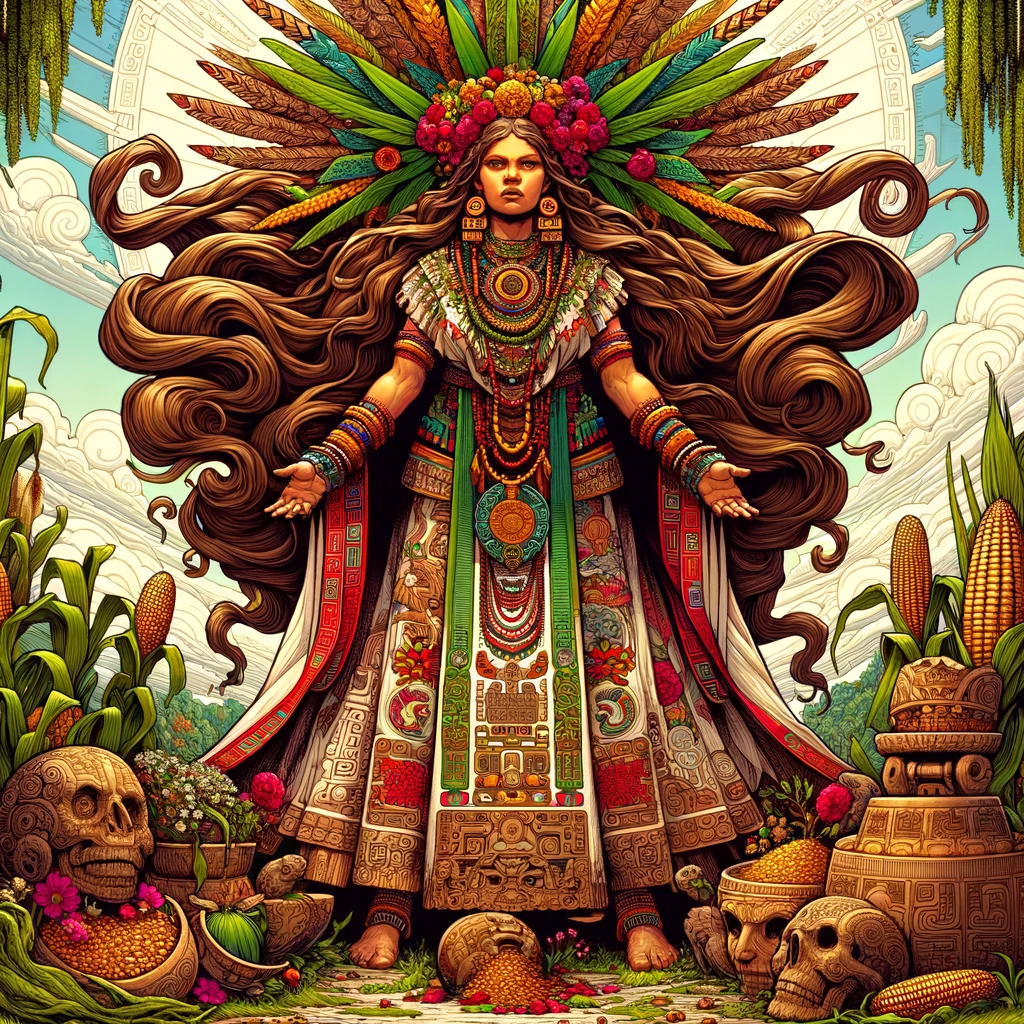
In the pantheon of Aztec deities, where gods and goddesses represented the fundamental aspects of life and the cosmos, Ilamatecuhtli holds a distinguished place. Known as the "Great Mother Goddess," she embodies fertility, earth, and motherhood, illustrating the Aztecs' deep reverence for the forces of nature and the cycle of life.
Mythology and Symbolism
Ilamatecuhtli, whose name translates to "Old Woman Goddess," is often depicted as a symbol of the earth's generative powers. She is portrayed as an aged woman wearing a skirt adorned with skulls and crossbones, signifying her association with death and rebirth. This imagery reflects the Aztec belief in the cyclical nature of life, where death gives way to life, and the earth plays a crucial role in this perpetual cycle.
In some myths, Ilamatecuhtli is considered the mother of the gods, or even the mother of the human race, highlighting her role as a creator deity. She is associated with both the nurturing aspects of the earth, providing sustenance and shelter, and its destructive forces, such as earthquakes and storms, which were seen as expressions of her displeasure.
Worship and Rituals
The worship of Ilamatecuhtli was intertwined with agricultural rituals and ceremonies aimed at ensuring fertility and bountiful harvests. Offerings of flowers, food, and incense were made to appease the goddess and gain her favor. The Aztecs also performed dances and songs in her honor, celebrating the life-giving aspects of the earth.
One of the most significant rituals associated with Ilamatecuhtli was the feast of Atamalcualiztli, which occurred every eight years. This event was marked by the creation of a large effigy of the goddess, which was paraded through the streets before being ceremonially destroyed. The destruction of the effigy symbolized the death and renewal of nature, reinforcing the connection between the goddess and the cycles of the earth.
Legacy and Interpretation
The legacy of Ilamatecuhtli in Aztec culture underscores the civilization's understanding of and respect for the natural world. As a deity embodying fertility and the earth, she represented the essential elements necessary for the survival and prosperity of the Aztec people. Her worship emphasized the interconnectedness of life, death, and rebirth, a concept that remains relevant in contemporary discussions about ecology and the environment.
Modern interpretations of Ilamatecuhtli often focus on her role as a symbol of female power and motherhood. She is seen as a figure who transcends the traditional boundaries of life and death, embodying the strength and resilience of women. In this way, Ilamatecuhtli continues to inspire, serving as a reminder of the enduring power of the natural world and the importance of respecting and protecting it.
Conclusion
Ilamatecuhtli's significance in Aztec mythology and culture provides insight into the civilization's values and beliefs. As a deity of fertility and the earth, she encapsulates the Aztecs' reverence for the natural world and their understanding of the cycles of life. Through her worship and the rituals dedicated to her, Ilamatecuhtli remains a potent symbol of creation, destruction, and renewal, echoing the timeless connection between humanity and the earth.
Mythology and Symbolism
Ilamatecuhtli, whose name translates to "Old Woman Goddess," is often depicted as a symbol of the earth's generative powers. She is portrayed as an aged woman wearing a skirt adorned with skulls and crossbones, signifying her association with death and rebirth. This imagery reflects the Aztec belief in the cyclical nature of life, where death gives way to life, and the earth plays a crucial role in this perpetual cycle.
In some myths, Ilamatecuhtli is considered the mother of the gods, or even the mother of the human race, highlighting her role as a creator deity. She is associated with both the nurturing aspects of the earth, providing sustenance and shelter, and its destructive forces, such as earthquakes and storms, which were seen as expressions of her displeasure.
Worship and Rituals
The worship of Ilamatecuhtli was intertwined with agricultural rituals and ceremonies aimed at ensuring fertility and bountiful harvests. Offerings of flowers, food, and incense were made to appease the goddess and gain her favor. The Aztecs also performed dances and songs in her honor, celebrating the life-giving aspects of the earth.
One of the most significant rituals associated with Ilamatecuhtli was the feast of Atamalcualiztli, which occurred every eight years. This event was marked by the creation of a large effigy of the goddess, which was paraded through the streets before being ceremonially destroyed. The destruction of the effigy symbolized the death and renewal of nature, reinforcing the connection between the goddess and the cycles of the earth.
Legacy and Interpretation
The legacy of Ilamatecuhtli in Aztec culture underscores the civilization's understanding of and respect for the natural world. As a deity embodying fertility and the earth, she represented the essential elements necessary for the survival and prosperity of the Aztec people. Her worship emphasized the interconnectedness of life, death, and rebirth, a concept that remains relevant in contemporary discussions about ecology and the environment.
Modern interpretations of Ilamatecuhtli often focus on her role as a symbol of female power and motherhood. She is seen as a figure who transcends the traditional boundaries of life and death, embodying the strength and resilience of women. In this way, Ilamatecuhtli continues to inspire, serving as a reminder of the enduring power of the natural world and the importance of respecting and protecting it.
Conclusion
Ilamatecuhtli's significance in Aztec mythology and culture provides insight into the civilization's values and beliefs. As a deity of fertility and the earth, she encapsulates the Aztecs' reverence for the natural world and their understanding of the cycles of life. Through her worship and the rituals dedicated to her, Ilamatecuhtli remains a potent symbol of creation, destruction, and renewal, echoing the timeless connection between humanity and the earth.